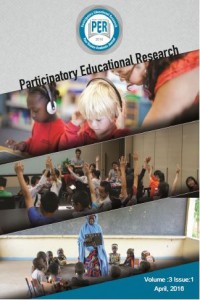Abstract
References
- Aborn, M. (2006). An intelligent use for belief. [Electronic version]. Education, 127(1), 83-85.
- Armstrong, T. (2000). Multiple intelligences in the classroom (2nd ed.). Alexandria, Virginia: ASCD.
- Gardner, H. (1983). Frames of mind. New York: Basic Books.
- Gardner, H. (1993). Multiple intelligences: The theory into practice. New York: Basic Books.
- Gardner, H. (2004). Audiences for the theory of multiple intelligences. Teachers College Record, 106 (1), 212-220. doi: 10.1111/j.1467-9620.2004.00329.x
- Johnson, K. & White, J. T. (2002). The use of multiple intelligences in criminal justice education. Journal of Criminal Justice Education, 13 (2), 369-386. doi: 10.1080/10511250200085531
- Kornhaber, M. L. (2004). Multiple intelligences: from the ivory tower to the dusty classroom - but why? Teachers College Record, 106, 67-76. doi: 10.1111/j.1467-9620.2004.00319.x
- Moran, S., Kornhaber, M. & Gardner, H. (2006). Orchestrating multiple intelligences. Educational Leaderships, 64 (10), 22-27. Retrieved from Academic Search Complete database.
- Nolen, J. L. (2003). Multiple intelligences in the classroom. Education, 124 (1), 115-119.
- Selçuk, Z., Kayılı, H. ve Okut, L. (2003). Çoklu zeka uygulamaları (3rd ed.) Ankara: Nobel.
- Shearer, C. B. (2005). Which multiple intelligences assessment is appropriate for your purposes? Retrieved January 24, 2009, from http://www.miresearch.org/files/Is_MIDAS_Appropriate.doc
- Shepard, J. S. (2004). Multiple ways of knowing: fostering resiliency through providing opportunities for participating in learning. Reclaiming Children and Youth, 12 (4), 210-216. Retrieved from Academic Search Complete database.
- Strauss, A. & Corbin, J. (1990). Basics of qualitative research. Grounded theory procedures and techniques. Newbury Park, California: Sage.
- Sternberg, R. J.(2003). Cognitive psychology (3rd ed.). Belmont: Thomson Wadsworth.
- Yıldırım, A. ve Şimşek, H. (2003) Sosyal bilimlerde nitel araştırma yöntemleri. (3rd ed.). Ankara: Seçkin.
- Yılmaz, G. & Fer, S. (2003). The students’ opinion and achievement concerning instructional activities based on multiple intelligences theory. Hacettepe Üniversitesi Eğitim Fakültesi Dergisi, 25, 235-245. Retrieved from ULAKBIM Turkish National Databases
- Wehrheim, A., C. (2006). Current research in learning, the brain, intelligences, and bullying. The Clergy Journal, 82 (4), 9-10. Retrieved from Academic Search Complete database.
Abstract
The current study was conducted with the purpose of discovering the incompetence of instrument/inventory usage that 1st, 2nd and 3rd grade teachers utilize to determine their students’ multiple intelligences profiles. By this way, the study specifically aims to portray “what” and “what should be” for determining multiple intelligences profiles from methodological dimensions of “using instruments/inventories.” The study was an action research through employing criterion sampling method. There were various groups of participants involved in this study. Interviews, observations, and written document analysis were the main data collection methods. Data collection instruments and procedures included interview logs, observation forms, observation notes, evaluation of existing instruments including the Teele Inventory for Multiple Intelligences (TIMI), Multiple Intelligences (MI) Domains Inventory for Educators, MI Domains Observation Form for Students, Multiple Intelligences Inventory for Adults, and Multiple Intelligences Checklist for Students . Descriptive and qualitative content analyses were conducted. The data analysis indicated that most of the tools currently used were demonstrated a great deal of methodological weaknesses and were not appropriate for unveiling the intelligences properly. Also, their existing applications shed light that these tools were not appropriate enough and ignored many cultural aspects in determining intelligences. On the basis of Gardner’s speech and related literature, it can be expressed that intelligences could not be identified and assessed via single method, especially paper-pencil instrument formats. Nevertheless, MIT is based on a multiplicity approach and requires combining great effort to reveal intelligences in a correct manner.
References
- Aborn, M. (2006). An intelligent use for belief. [Electronic version]. Education, 127(1), 83-85.
- Armstrong, T. (2000). Multiple intelligences in the classroom (2nd ed.). Alexandria, Virginia: ASCD.
- Gardner, H. (1983). Frames of mind. New York: Basic Books.
- Gardner, H. (1993). Multiple intelligences: The theory into practice. New York: Basic Books.
- Gardner, H. (2004). Audiences for the theory of multiple intelligences. Teachers College Record, 106 (1), 212-220. doi: 10.1111/j.1467-9620.2004.00329.x
- Johnson, K. & White, J. T. (2002). The use of multiple intelligences in criminal justice education. Journal of Criminal Justice Education, 13 (2), 369-386. doi: 10.1080/10511250200085531
- Kornhaber, M. L. (2004). Multiple intelligences: from the ivory tower to the dusty classroom - but why? Teachers College Record, 106, 67-76. doi: 10.1111/j.1467-9620.2004.00319.x
- Moran, S., Kornhaber, M. & Gardner, H. (2006). Orchestrating multiple intelligences. Educational Leaderships, 64 (10), 22-27. Retrieved from Academic Search Complete database.
- Nolen, J. L. (2003). Multiple intelligences in the classroom. Education, 124 (1), 115-119.
- Selçuk, Z., Kayılı, H. ve Okut, L. (2003). Çoklu zeka uygulamaları (3rd ed.) Ankara: Nobel.
- Shearer, C. B. (2005). Which multiple intelligences assessment is appropriate for your purposes? Retrieved January 24, 2009, from http://www.miresearch.org/files/Is_MIDAS_Appropriate.doc
- Shepard, J. S. (2004). Multiple ways of knowing: fostering resiliency through providing opportunities for participating in learning. Reclaiming Children and Youth, 12 (4), 210-216. Retrieved from Academic Search Complete database.
- Strauss, A. & Corbin, J. (1990). Basics of qualitative research. Grounded theory procedures and techniques. Newbury Park, California: Sage.
- Sternberg, R. J.(2003). Cognitive psychology (3rd ed.). Belmont: Thomson Wadsworth.
- Yıldırım, A. ve Şimşek, H. (2003) Sosyal bilimlerde nitel araştırma yöntemleri. (3rd ed.). Ankara: Seçkin.
- Yılmaz, G. & Fer, S. (2003). The students’ opinion and achievement concerning instructional activities based on multiple intelligences theory. Hacettepe Üniversitesi Eğitim Fakültesi Dergisi, 25, 235-245. Retrieved from ULAKBIM Turkish National Databases
- Wehrheim, A., C. (2006). Current research in learning, the brain, intelligences, and bullying. The Clergy Journal, 82 (4), 9-10. Retrieved from Academic Search Complete database.
Details
| Primary Language | English |
|---|---|
| Subjects | Studies on Education |
| Journal Section | Research Articles |
| Authors | |
| Publication Date | April 1, 2016 |
| Acceptance Date | January 12, 2016 |
| Published in Issue | Year 2016 Volume: 3 Issue: 1 |


